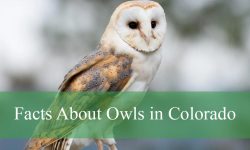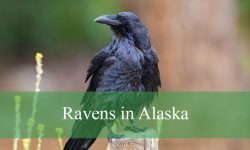It’s likely that you have seen little lizards dashing by your feet if you have ever wandered through Florida. The wildlife of Florida is remarkably diverse, with a large diversity of lizards among them. The purpose of this article is to familiarize you with some of the most common lizards you may see in Florida, so you can learn to recognize them and enjoy the local fauna.
It’s amazing to learn that there are 64 species of lizards in Florida, and most of them are non-native. The warm climate of Florida has proven to be an ideal habitat for these lizards, which were brought in through the exotic pet trade. As a result, the state has become a sanctuary for numerous exotic reptile species.
Different Types of Lizards in Florida
Butterfly lizard
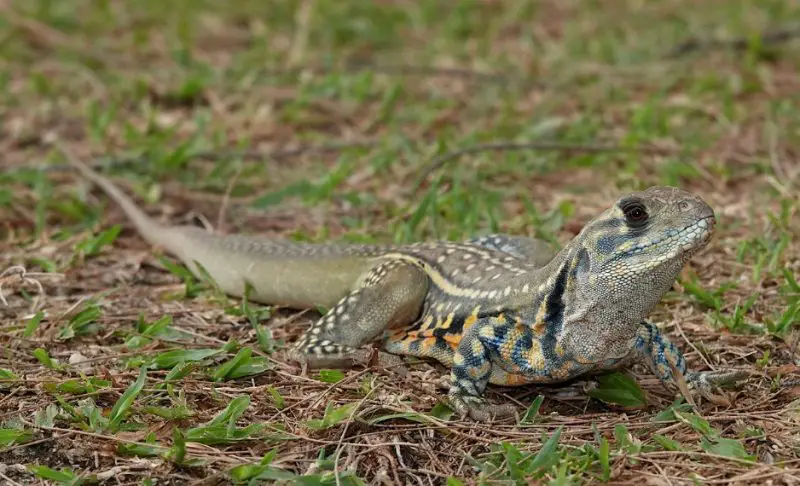
The butterfly lizard (genus Leiolepis), also known as the butterfly agama, is named for its striking markings: yellow spots on the back and orange and black lines on the sides. Since being introduced to Florida, they have established a healthy population. These lizards prefer living on agricultural land and sandy coastal areas. Their beautiful patterns make them distinctive, and they thrive in their new environment.
Oriental Garden Lizard
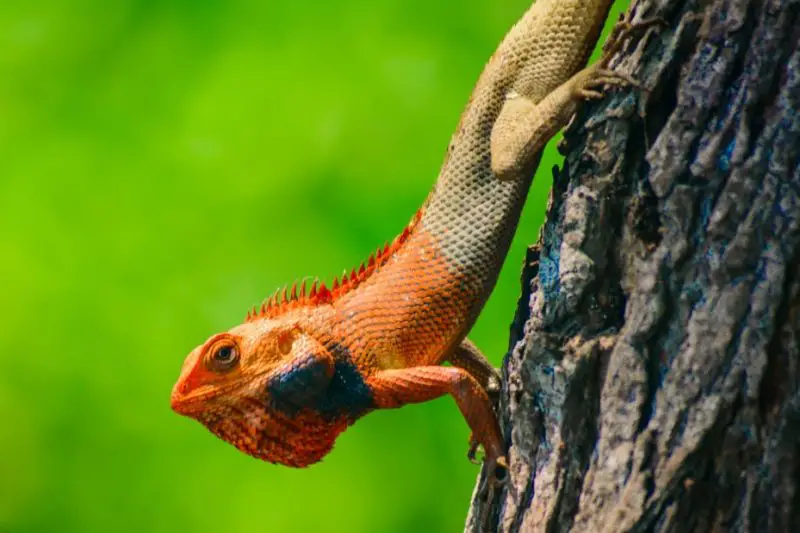
The oriental garden lizard (Calotes versicolor), also known as the eastern garden lizard, Indian garden lizard, common garden lizard, bloodsucker, or changeable lizard, features a striking red throat during the breeding season. They grow up to 14.5 inches (37 cm) in total length. Typically brown olive, they can change to black or bright red. Males often display black limbs and tail with a bright yellow and red head and neck during mating season, from May to October.
Green anole

The green anole (Anolis carolinensis), also known as the Carolina anole or American chameleon, is native to North America. These small to medium-sized, slender lizards have long, pointed heads. Males feature a bright red throat fan three times larger than the females’, whose fans are usually white to pale pink. Females have a distinguishing white stripe on their spine. They can grow up to 8 inches (20 cm) in total length, with the tail comprising up to seventy percent of this length.
Brown anole
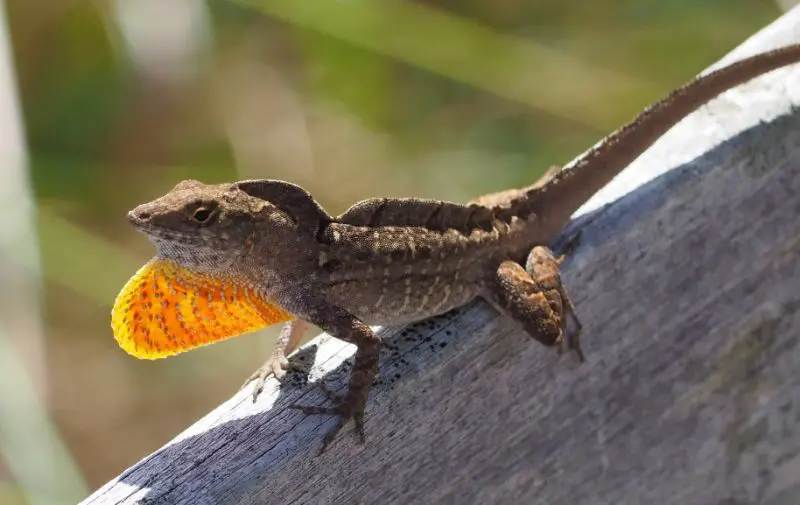
The brown anole (Anolis sagrei), also known as the Cuban brown anole or De la Sagra’s anole, is light brown with black or dark brown markings on its back and tan to light lines on the sides. They can change color, usually to a darker brown. Their throat fan ranges from orange-red to yellow. Males grow up to 8 inches (20 cm) in total length, while females are slightly smaller, around 5.9 inches (15 cm).
Bark anole
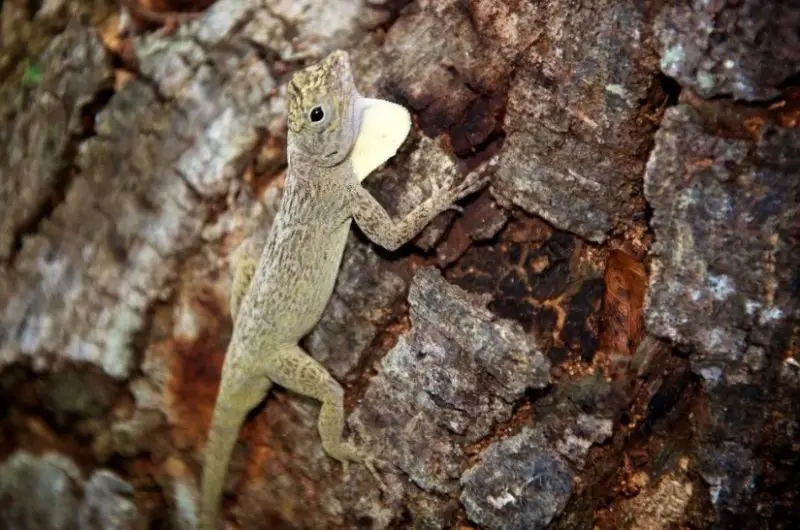
The bark anole (Anolis distichus), also known as the North Caribbean bark anole or Hispaniolan gracile anole, is native to the Bahamas and Hispaniola, and was introduced to Florida in the 1940s. These small anoles, growing up to 5 inches (12.7 cm) including the tail, spend most of their time basking on tree trunks. Their color ranges from green to brown/gray, with a throat fan that can be orange, red, or yellow.
Knight anole
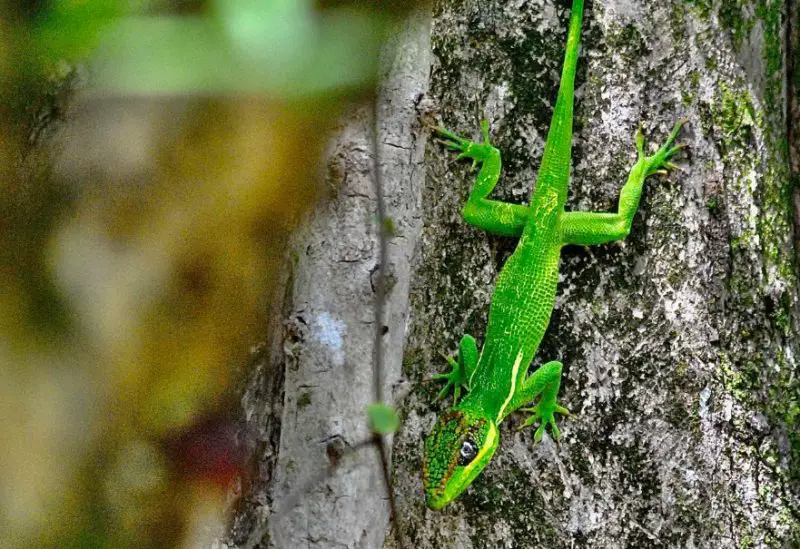
The knight anole (Anolis equestris), also known as the Cuban knight anole or Cuban giant anole, is a large anole species growing up to 20 inches (51 cm) in total length, with a tail longer than its body. Males are larger than females and are typically bright green with a yellow stripe on the side of the head and shoulder. Their throat fan is pink/white. Juveniles can be identified by light banding on their bodies. These anoles are active during the day and highly territorial.
Common Puerto Rican anole

The common Puerto Rican anole (Anolis cristatellus), also known as the crested anole, is robust and aggressive compared to other anoles. It reaches about 3 inches (7.5 cm) in length, excluding the tail, with males being larger than females. Males feature a distinctive fin-like sail along their tails. Their coloration ranges from green/gray to bronze with light brown spots, a green to yellow belly, and a burnt orange throat fan.
Large-headed anole
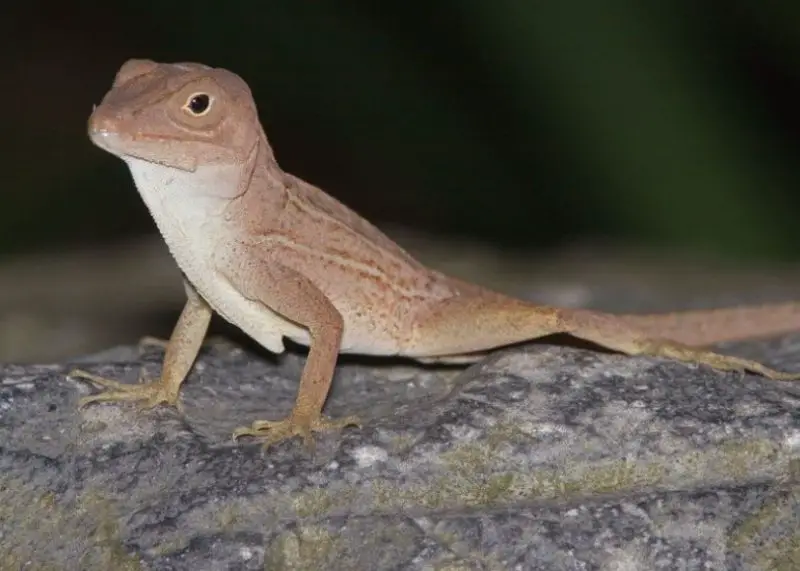
The large-headed anole (Anolis cybotes), also known as the Tiburon stout anole or Hispaniolan stout anole, originates from Hispaniola and nearby islands. Since being introduced to South Florida, it has established stable breeding populations. Males of this species are characterized by their large heads and brown coloration, with lighter stripes along the sides. They are well-adapted to their new environment and contribute to the local ecosystem as an introduced species.
Cuban green anole
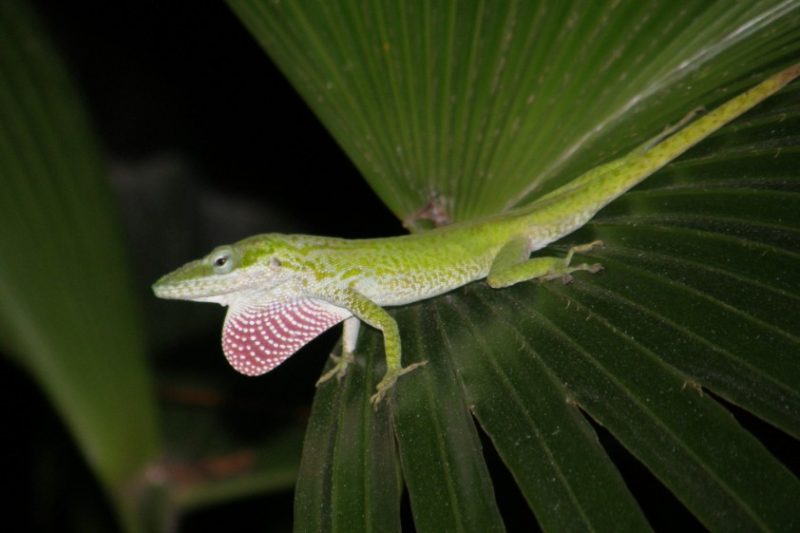
The Cuban green anole (Anolis porcatus), a member of the Carolinensis group, originates from Cuba. Since being introduced to Florida, it has successfully established stable breeding populations across the state. This adaptable lizard is known for its green coloration, which serves as camouflage in its natural habitat. In Florida, it occupies various habitats, including urban areas, demonstrating its ability to thrive in diverse environments despite being introduced outside its native range.
Hispaniolan green anole
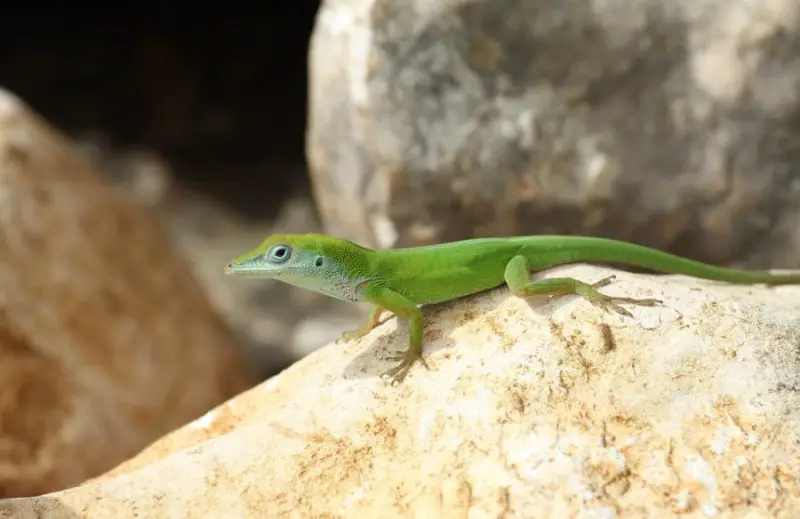
The Hispaniolan green anole (Anolis chlorocyanus), also known as the Tiburon green anole or Jeremie anole, hails from Hispaniola Island and shares similarities with the North American green anole. Males of this species are distinguished by their light blue throat fans, contrasting with the red throat fans of North American green anoles. Females and juveniles display dark green stripes along their bodies, while males exhibit a bright green coloration. They have successfully established habitats in southern Florida since their introduction.
Jamaican giant anole
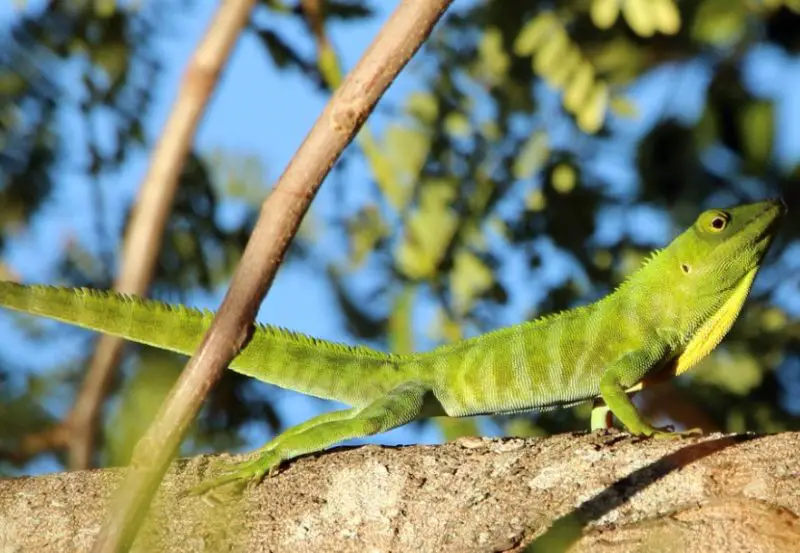
The Jamaican giant anole (Anolis garmani), also known as the Jamaica giant anole, is a large lizard reaching up to 10.6 inches (27 cm) in total length, tail included. These anoles are primarily green but can turn brown during the night. Males display orange coloration at the center of their throat fan, while females have a smaller and darker-looking throat fan. They are native to Jamaica and are known for their size and distinct color patterns.
Northern Curly Tailed Lizard
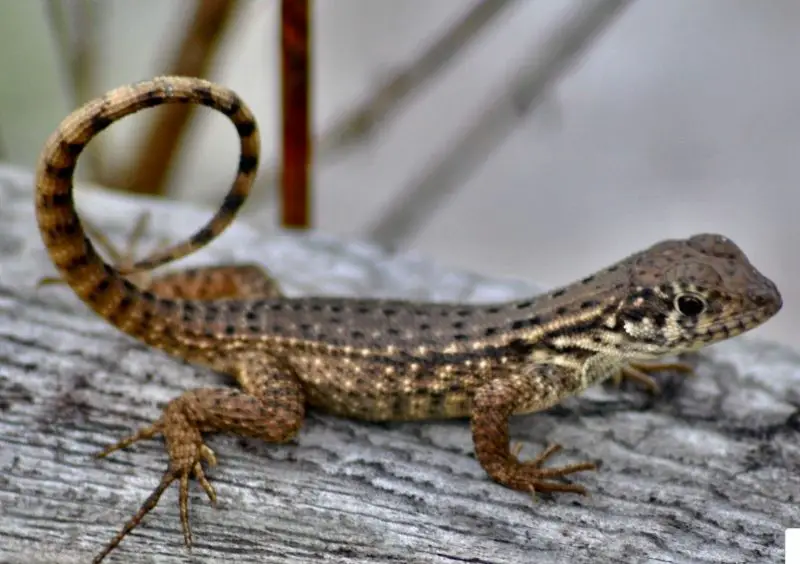
The Northern curly-tailed lizard (Leiocephalus carinatus) is native to the Bahamas, Cayman Islands, and Cuba. Introduced in Palm Beach, Florida, to control pests in sugar canes, it now inhabits other parts of Florida. Adults grow up to 10 inches (26 cm) long. These active lizards prefer sunny areas with rocks and rubble. They play dead when captured, remaining motionless for a while after being released.
Red Sided Curly Tailed Lizard
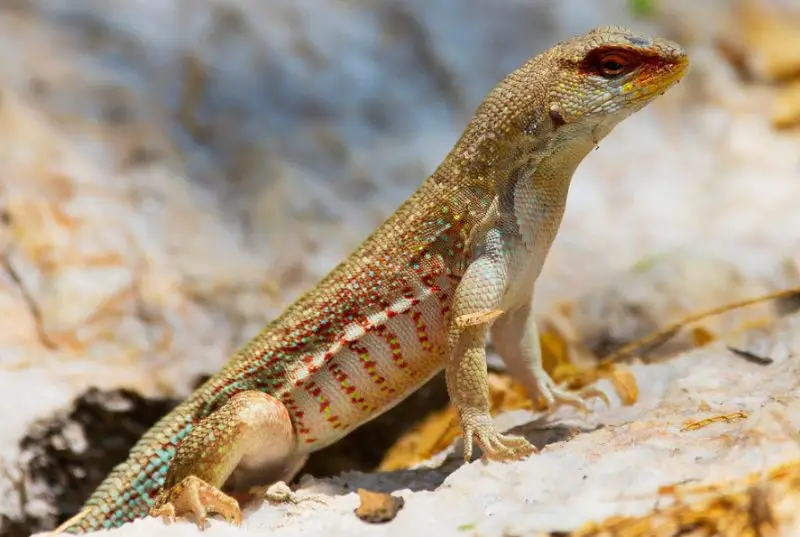
The red-sided curly-tailed lizard (Leiocephalus schreibersii), also known as the Hispaniolan curlytail, Hispaniolan khaki curlytail, or Schreibers’ curly-tailed lizard, is an introduced species. Belonging to the Leiocephalidae family, this lizard is active during the day. It grows up to 6 cm in body length, excluding the tail. Quick and agile, it swiftly runs for cover when approached to evade predators.
Indo-Chinese Forest Lizard
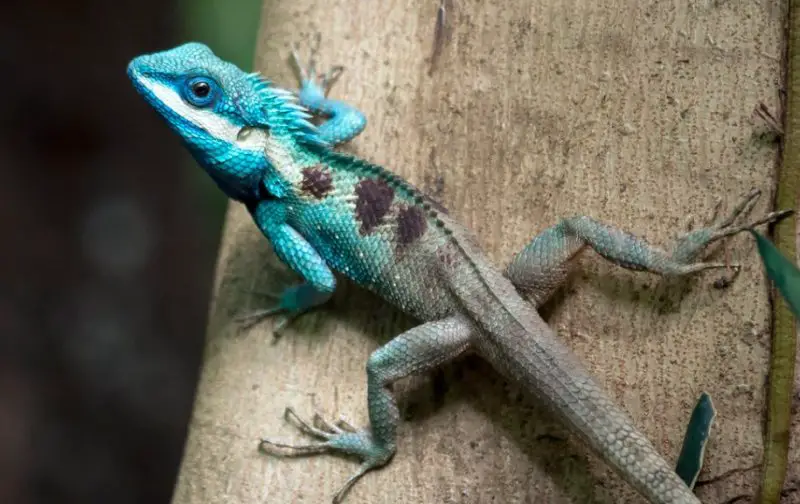
The Indo-Chinese forest lizard (Calotes mystaceus), also known as the blue-crested lizard, is an introduced species. It has smooth scales and small spines on both sides of its head, with a compressed tail. Its body color ranges from olive to gray, featuring red spots on the back and yellow lips. These lizards can grow up to 42 cm in total length, including the tail.
Common agama
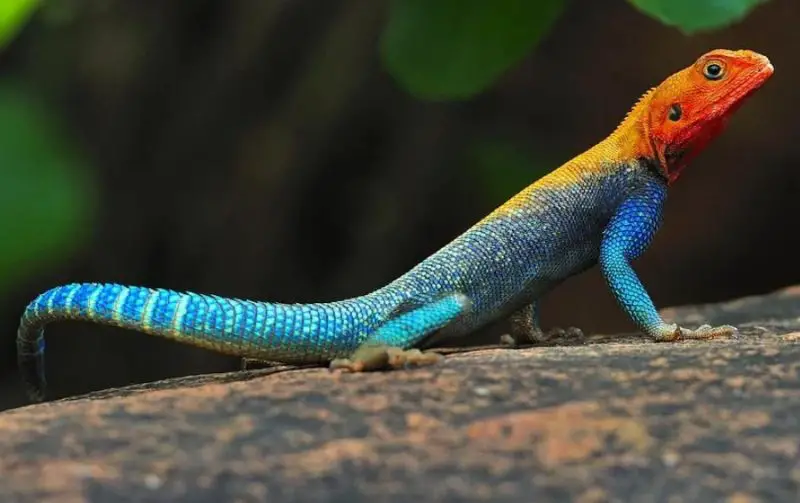
The common agama (Agama agama), also known as the red-headed rock agama or rainbow agama, is an introduced species. Typically brown or gray, they undergo striking color changes during the breeding season, turning bright blue, red, or yellow. Commonly found in household yards, grasslands, and bushy areas, these lizards have a yellow or red head. Despite their fierce appearance, they are very shy and will quickly run for cover if approached.
Florida scrub lizard
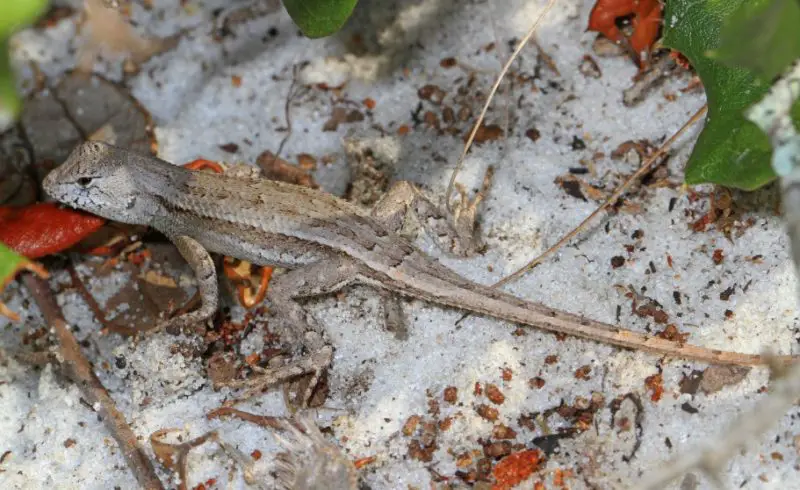
The Florida scrub lizard (Sceloporus woodi) measures approximately 5 inches (13 cm) in total length, tail included. It is typically brown or gray, with distinct brown stripes running down each side of its body. Males exhibit turquoise coloring on their bellies and throats, while females lack this feature and may display lighter patches on their bellies. Found in scrub habitats such as sand pine and evergreen oak scrub, they are commonly seen basking in sunny, dry, open areas.
Eastern fence lizard
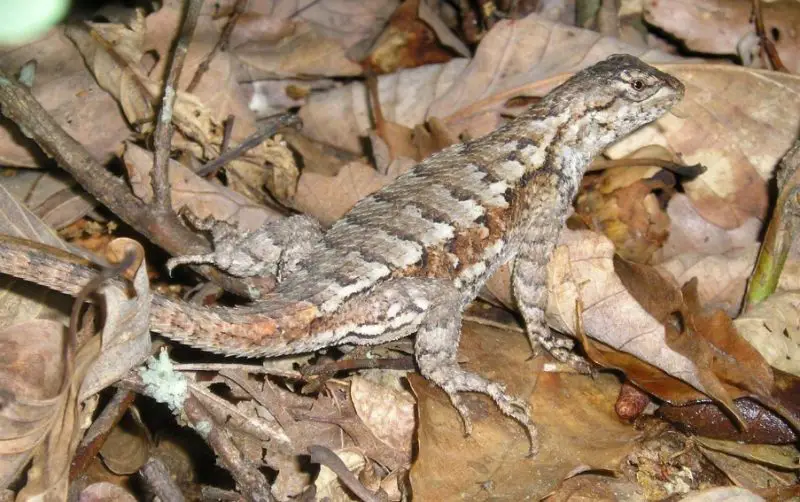
The Eastern fence lizard (Sceloporus undulatus), also known as the prairie lizard or northern fence lizard, grows up to 7.5 inches (19 cm) in length, tail included. They are typically brown or gray, with keeled scales and a dark line along the back of the thighs. Females are gray with dark, wavy lines on their backs, white bellies, and sometimes light blue markings on their belly and throat. Males have brown bodies in summer, with green/blue and black markings on their throat and belly. They prefer sunny, wooded areas and are active in the morning, seeking shelter during hot periods.
Green iguana
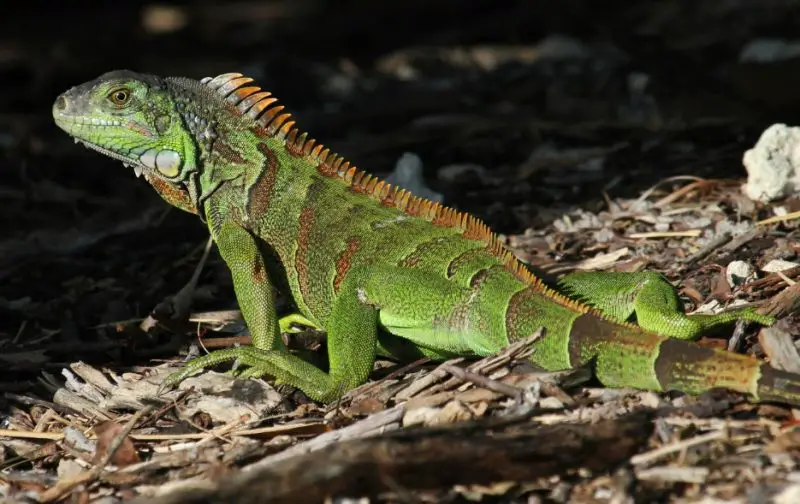
The green iguana (Iguana iguana), also known as the American iguana, can reach lengths of 5.6 feet (1.7 m) including their tail, which is longer than their body. Males can weigh up to 4 kg, slightly heavier than females at up to 3 kg. They are recognized by the row of spines on their tails and back, which serve as protection. With whip-like tails capable of regenerating if broken, they use their well-developed throat fan for territorial and breeding displays. When threatened, they will flee and may dive into water to escape predators.
Black spiny-tailed iguana
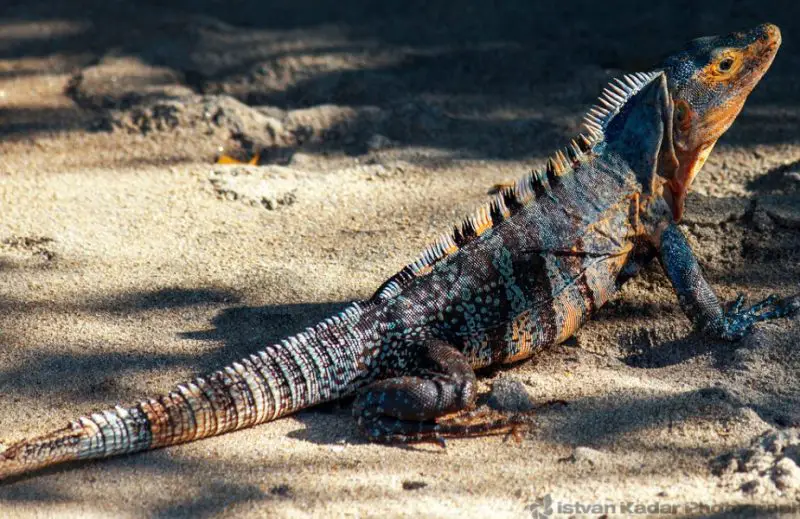
The black spiny-tailed iguana (Ctenosaura similis), also known as the black iguana or black ctenosaur, has black keeled scales on its tail. Males can grow up to 4 feet, 3 inches (1 meter) long, with females slightly smaller. They feature spines down their backs and vary in color, typically tan or gray with dark bands. During mating season, males develop orange heads and throats, along with blue and peach colors on their jowls. Introduced to South Florida, they thrive in feral populations from North Collier County to Tampa Bay, including Key Biscayne, Broward County, and Hialeah.
Mexican spiny-tailed iguana
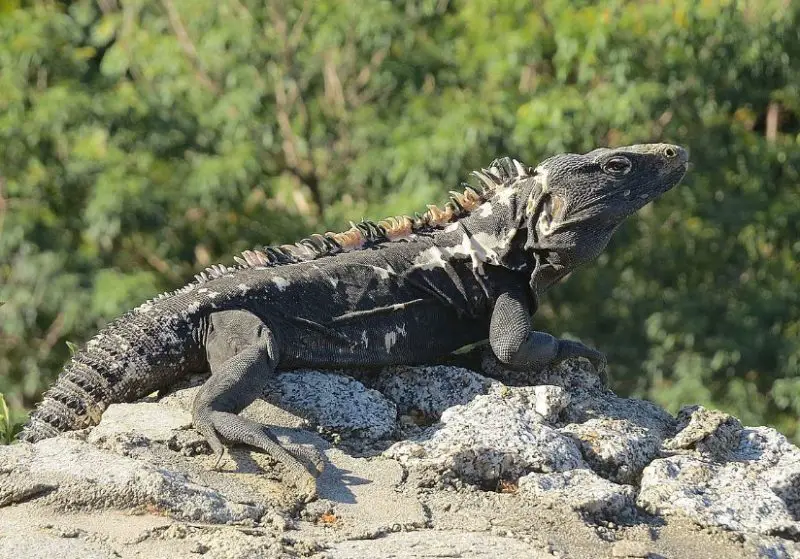
The Mexican spiny-tailed iguana (Ctenosaura pectinata), also known as the western spiny-tailed iguana, grows up to 1.3 meters long, with females slightly smaller. They are gray/brown to brown with yellow bellies and long spines down their backs. Juveniles are bright green and become darker with age. Originally from Western Mexico, they were introduced to South Florida, where they now thrive in feral populations found in Broward County, Key Biscayne, Hialeah, and Gasparilla Island since their initial release in 1970.
Brown Basilisk
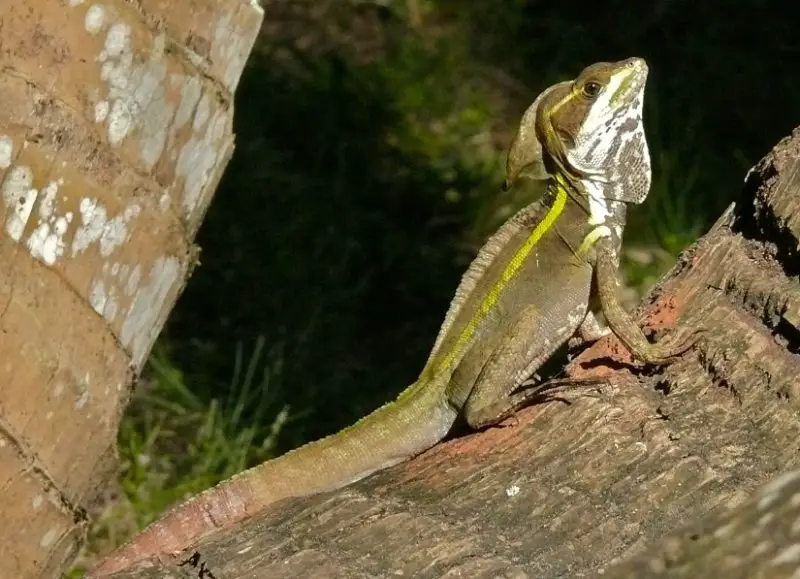
The brown basilisk (Basiliscus vittatus), or striped basilisk, grows up to 24 inches (61 cm) long, tail included. They are olive-brown to brown with distinctive crossbanding on their dorsal crest and flanks. A white stripe runs from their eye to hind legs. Males have large crests and sharp claws on long toes. Notably, they can run on water for about 20 meters (66 feet), facilitated by flaps on their hind feet that enhance surface area for buoyancy.
Veiled chameleon
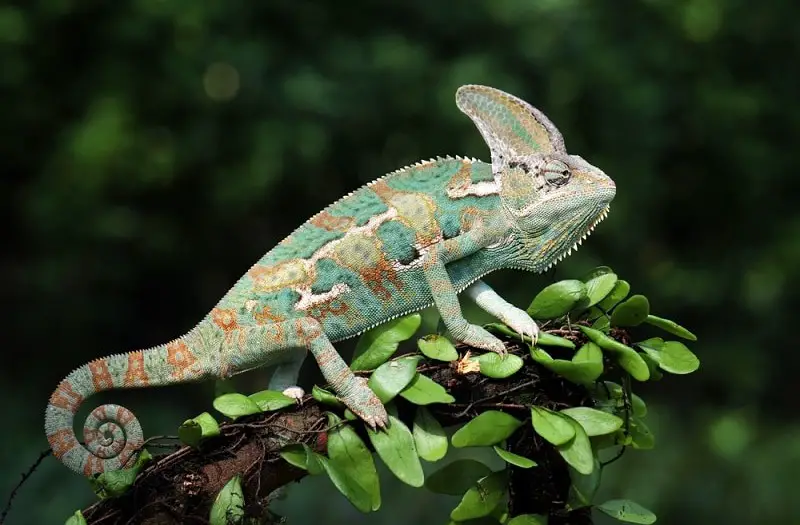
The veiled chameleon (Chamaeleo calyptratus), known as the cone-head or Yemen chameleon, reaches lengths of up to 24 inches (61 cm), including its tail. Females are shorter and stouter compared to males. Juveniles start off green and develop stripes as they mature. Adult females display green hues with mottling in orange, white, yellow, and tan, while males exhibit brighter colors with distinct yellow or blue bands. Their ability to change color is influenced by temperature and stress. In Florida, they have established stable wild populations after escaping captivity, favoring warm habitats like mountains and valleys.
Oustalet’s chameleon
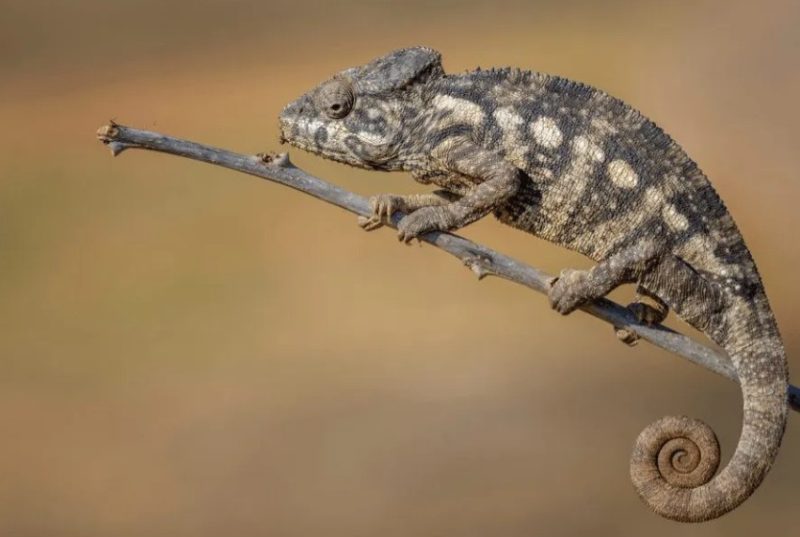
Oustalet’s chameleon (Furcifer oustaleti), also known as the Malagasy giant chameleon, is the largest chameleon species, reaching up to 27 inches (68.5 cm) in length. They feature tall casques on their heads with crests and small triangular spines along their spines. Typically brown or gray, females exhibit more vibrant colors than males. Native to Madagascar, they have been introduced to Florida, where they inhabit forests, agricultural lands, and urban areas.
Jackson’s chameleon
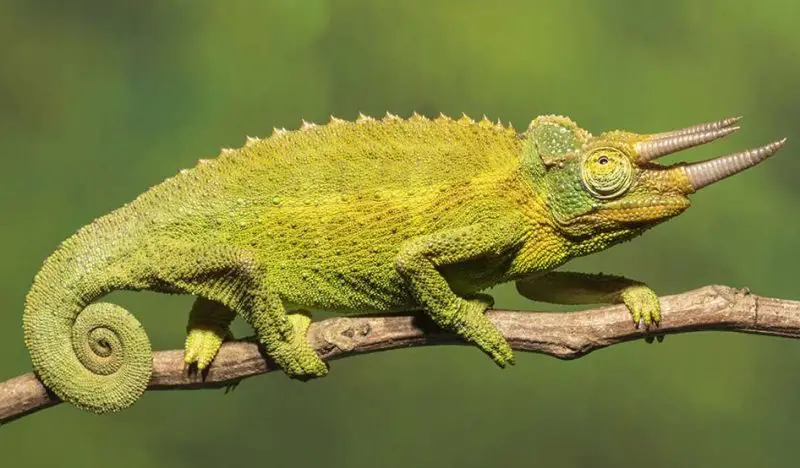
Jackson’s chameleon (Trioceros jacksonii), also called the Jackson’s horned chameleon or three-horned chameleon, was introduced to areas outside its native habitat. Males are distinguished by three brown horns: one on the nose and two on the orbital ridge above the eyes. Females lack these horns. They are typically bright green, sometimes with hints of yellow or blue, and can change color based on health, mood, and temperature. Adults reach up to 15 inches (38 cm) in length, with females slightly smaller.
Six-lined Racerunner
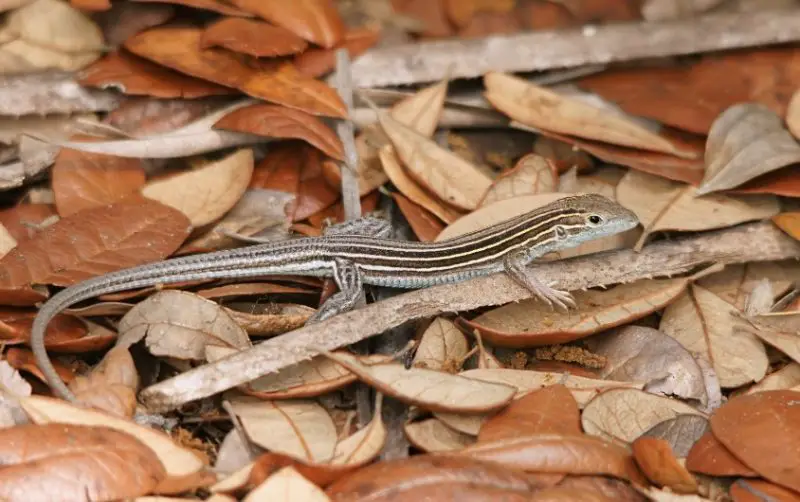
The brown, black, or dark green coloring and six distinct green/yellow to yellow stripes that run from head to tail are the defining features of the six-lined racerunner, or Aspidoscelis sexlineatus. Males have a pale green neck and light blue belly, while females have white bellies. Their tails, which are twice as long as they are, add to their slim build. They can travel up to 29 kilometers per hour and are quite alert. They live in a variety of habitats, such as grasslands, rocky outcrops, wide floodplains, and forests.
Giant Ameiva
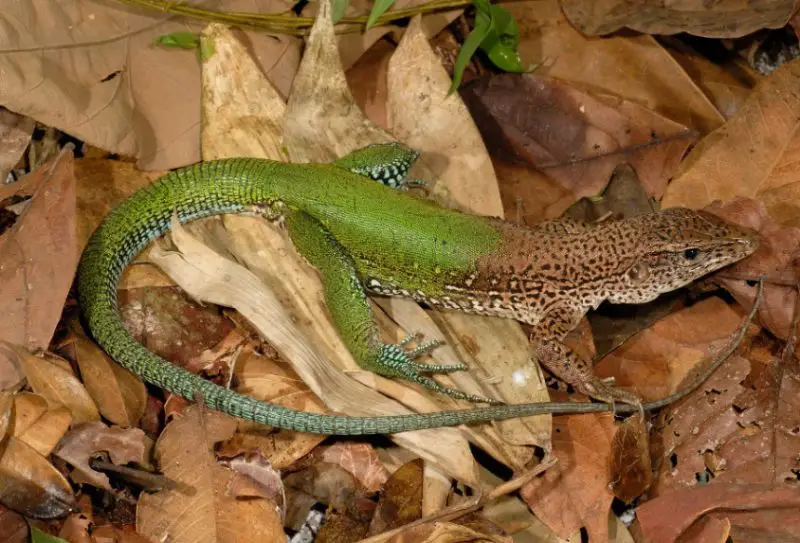
The Giant Ameiva, scientifically known as Ameiva ameiva, is a striking lizard found in South America. It boasts a pointed head with a forked tongue, and its streamlined body features powerful hind legs. These lizards can reach lengths of up to 20 inches (50 cm). Males display vibrant green hues, whereas females exhibit lighter tones, both adorned with black spots and mottling along their sides. Preferring forested habitats, they thrive amidst leaf litter and beneath logs, making them adept at ground-dwelling camouflage.
Rainbow Whiptail
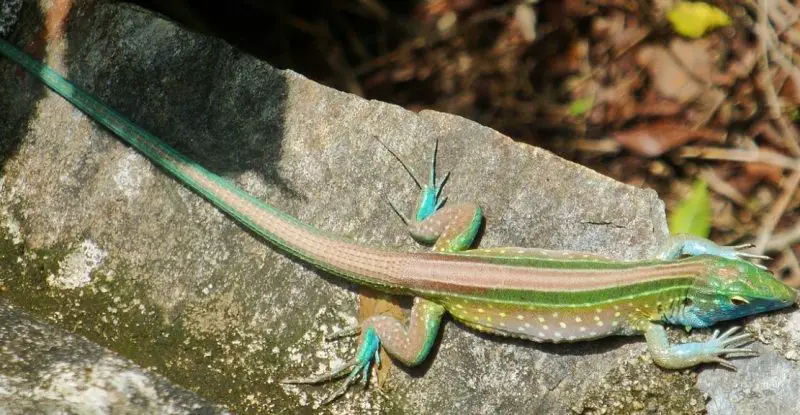
The Rainbow Whiptail, scientifically named Cnemidophorus lemniscatus, is a lizard native to Central America and the Caribbean. It has been introduced to Florida, where it has successfully established stable populations. These whiptails typically reach lengths of about 12 inches (30.5 cm) and are known for their swift agility, often fleeing when approached. Their vibrant appearance and adaptability have facilitated their spread in the introduced habitats, where they thrive amidst varied environments.
Argentine black and white tegu

The Argentine Black and White Tegu, or Salvator merianae, starts off as emerald green with black markings, later turning completely black. Juveniles have yellow and black banded tails, which become solid yellow as they mature. Known for their speed and strong tails used defensively, males can reach 140 cm (4.5 feet) in length. These tegus are popular as exotic pets due to their intelligence and ability to be trained.
Reef gecko
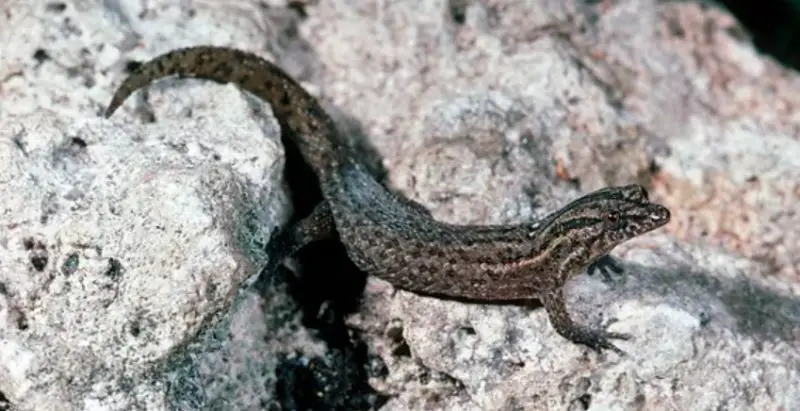
The Reef Gecko, scientifically named Sphaerodactylus notatus, also known as the Florida reef gecko or brown-speckled sphaero, is native to the United States. These secretive lizards have round bodies and large, keeled scales on their backs, reaching lengths of up to 2.25 inches (5.7 cm). They sport brown bodies with dark spots, and females feature three wide, dark stripes on their heads. Found from the Florida Keys to southeastern Florida, they prefer habitats like vacant lots, pinelands, and hammocks, and are most active at dusk, foraging between hiding spots for food.
Ocellated gecko
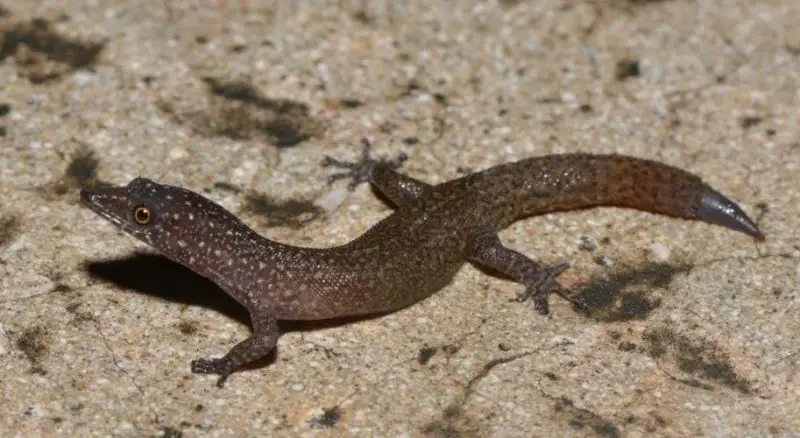
The Ocellated Gecko (Sphaerodactylus argus), also known as ocellated sphaero or stippled sphaero, originates from Jamaica and has been introduced to the Florida Keys, where it thrives in stable populations. These geckos favor forested habitats but are frequently found in urban settings, commonly seen on the walls of homes and buildings.
White-spotted wall gecko
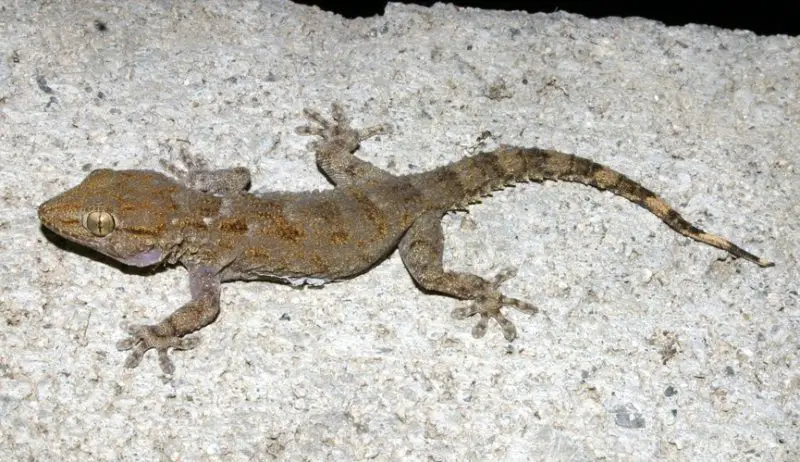
The White-spotted Wall Gecko (Tarentola annularis) is a large lizard reaching up to 8 inches (15 cm) in length. Found in various locations in Florida after being introduced, they originate from Saharan areas. These geckos are gray to tan in color with four distinctive white spots on their shoulders, and they have bulging eyes and a skin texture resembling warts. They are commonly observed on building walls in Florida and can bite if handled.
Flat-tailed House Gecko
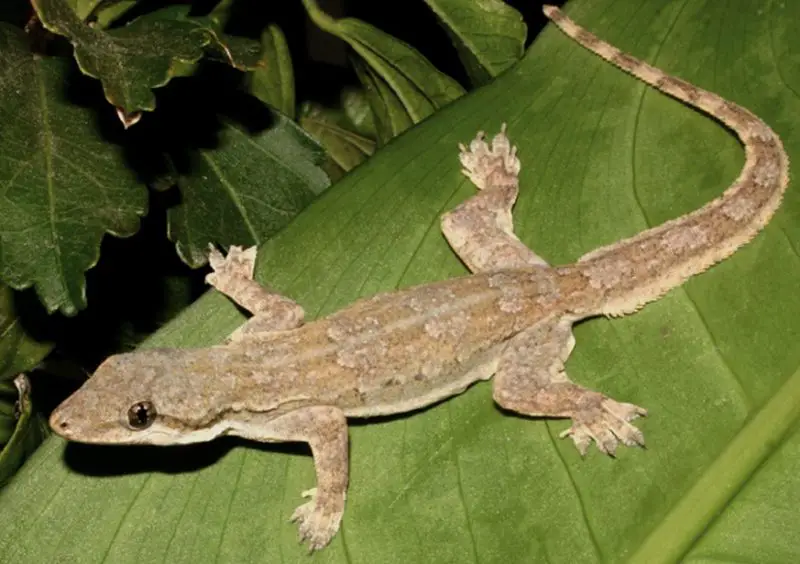
The Flat-tailed House Gecko (Hemidactylus platyurus), also known as the frilled house gecko or Asian house gecko, features a long snout and concave forehead. Gray in color, they sport a dark band from eye to shoulder and have flat tails with a sharp lateral edge. These geckos can grow up to 6 cm in body length, with tails longer than their bodies. Introduced to Florida, they are prevalent in Miami-Dade, Pinellas, Lee, Broward, and Alachua counties.
Ashy gecko
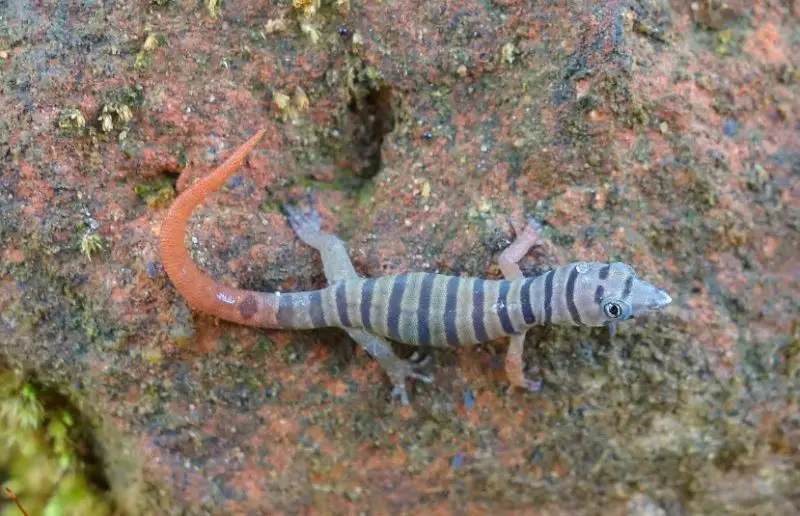
The Ashy Gecko (Sphaerodactylus elegans), native to the West Indies, was first identified in Florida in 1922, likely arriving via cargo shipments. Confined mainly to the Florida Keys, these geckos grow to just 3.9 cm in length. They are typically green with bands on their bodies and a red or blue tail, showing no distinguishing features between males and females.
Tokay gecko
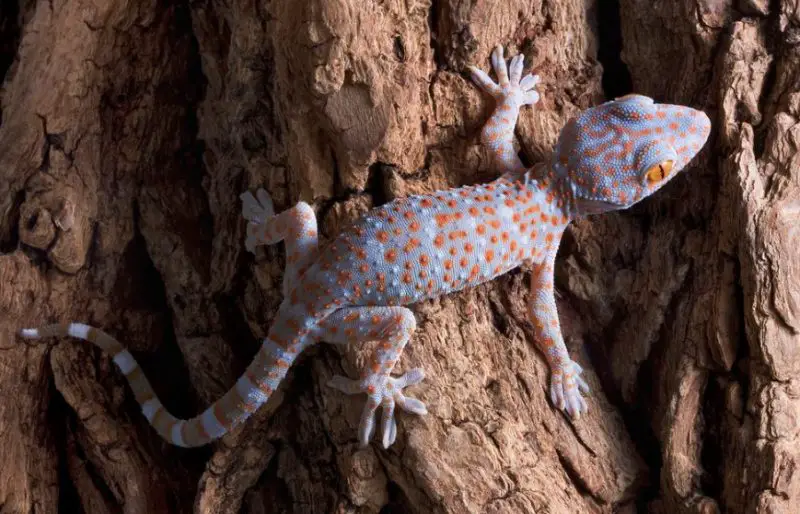
The Tokay Gecko (Gekko gecko), introduced to various regions, is notable for its large size, reaching up to 12 inches (30 cm) in length. With a flat yet cylindrical body, it features soft, gray skin adorned with red patches that aid in camouflage. Males are typically larger and more brightly colored than females. Known for their territorial and aggressive behavior, they possess a potent bite and excel as climbers in their habitats.
Mediterranean house gecko
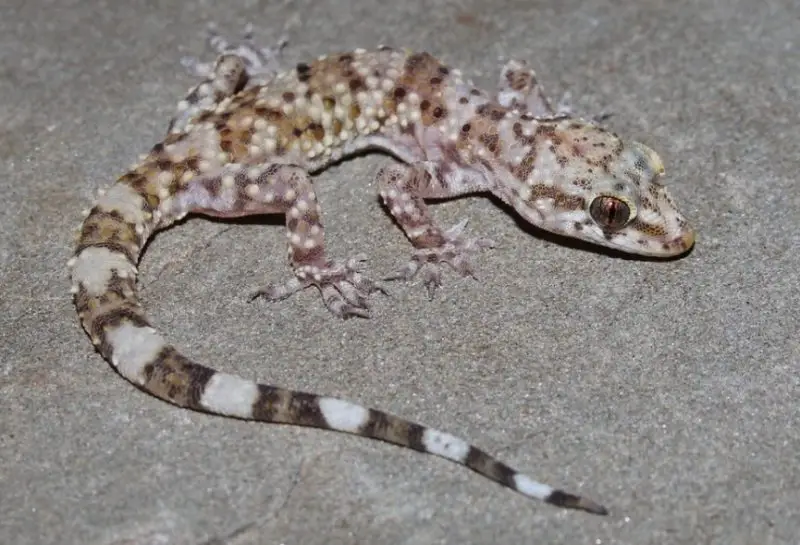
The Mediterranean House Gecko (Hemidactylus turcicus), also known as the Turkish gecko or moon lizard, is a small species reaching up to 5 inches (13 cm) in length. Characterized by sticky toe pads and large eyes, they are gray with dark patches. These geckos are nocturnal hunters often seen around outdoor lights where they prey on insects. Originally from Northern Africa and Southern Europe, they have established populations in Florida and the Florida Keys, favoring crevices and cracks as hiding spots during the day.
Tropical house gecko
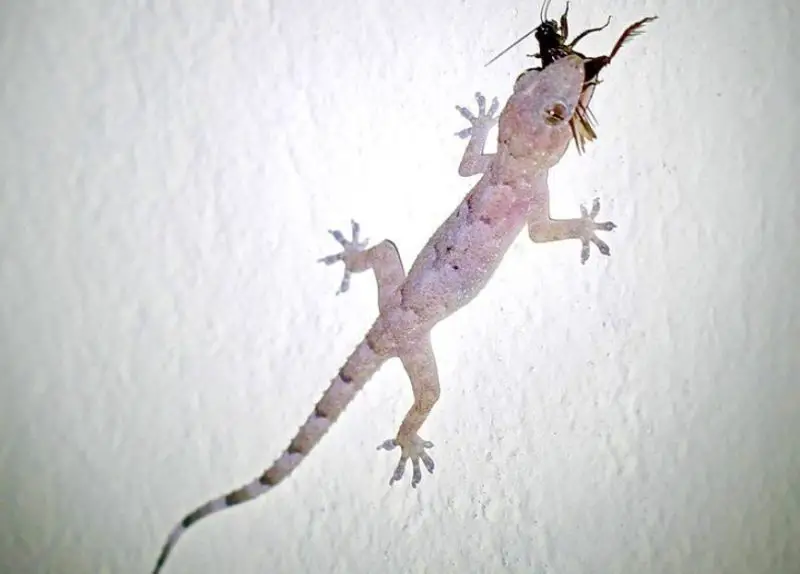
The Tropical House Gecko (Hemidactylus mabouia), also known as the Afro-American or cosmopolitan house gecko, reaches lengths of up to 5 inches (12.7 cm). Nocturnal by nature, they emerge at night to hunt prey. These geckos can adjust their coloration from light brown to dark brown to blend with their surroundings. Commonly sighted in urban settings, they are vocal creatures, emitting quick, high-pitched squeaks.
Bibron’s thick-toed gecko
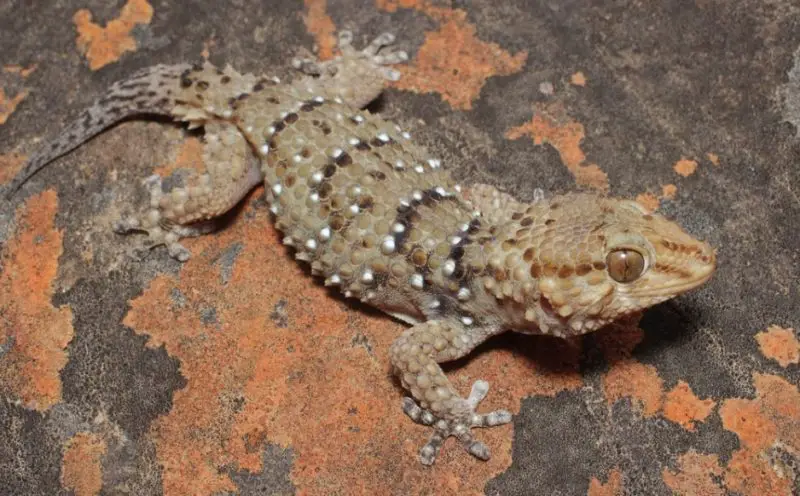
Bibron’s Thick-toed Gecko (Chondrodactylus bibronii), also known as Bibron’s sand gecko, is a robust lizard known for its armored appearance. Featuring large heads and short legs with swollen toepads, they vary in color from gray to brown to tan, often with dark bars and scattered white tubercles. Introduced to Florida in the 1970s, they can grow up to 5.5 inches (14 cm). Native to southern Africa, these geckos are smaller in Florida compared to their African counterparts and can deliver a painful bite if provoked.
Indo-Pacific gecko
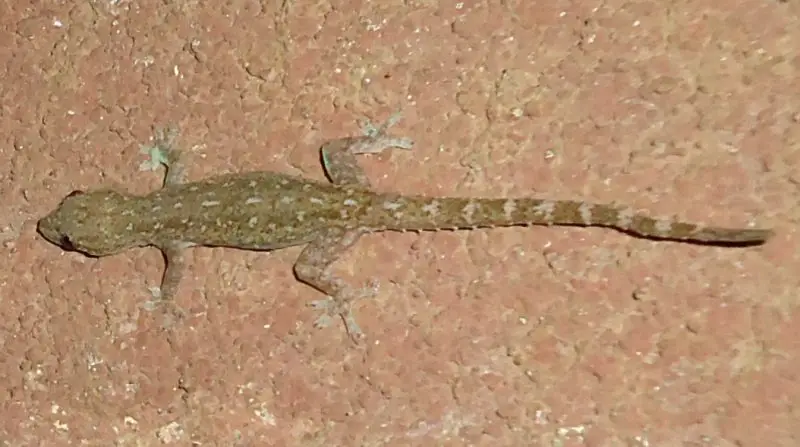
The Indo-Pacific Gecko (Hemidactylus garnotii), also known as Garnot’s house gecko or fox gecko, features a flat tail with spine-like scales along its edge. They exhibit an orange to yellow belly and a dark gray to brown body that appears translucent at night. Growing up to 5.5 inches (14 cm), these geckos thrive in southern Florida, where an all-female population excels as nocturnal hunters, adept at climbing to prey on insects.
Yellow-headed Gecko
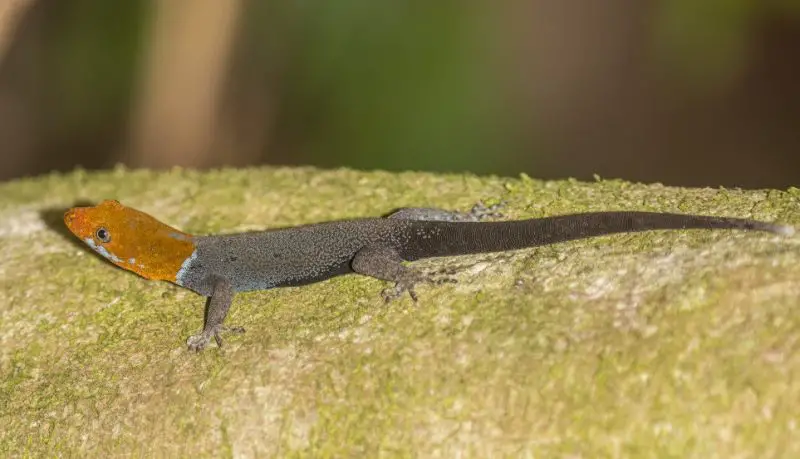
The Yellow-headed Gecko (Gonatodes albogularis) reaches lengths of 3.5 inches (9 cm). Males sport yellow heads and dark blue bodies, while females are typically mottled gray. They exhibit color changes from blue-green to gray when basking in sunlight. Native to the West Indies, they were introduced to the Florida Keys, where they inhabit rock piles and buildings. Their tails feature distinctive white tips.
Madagascan giant day gecko
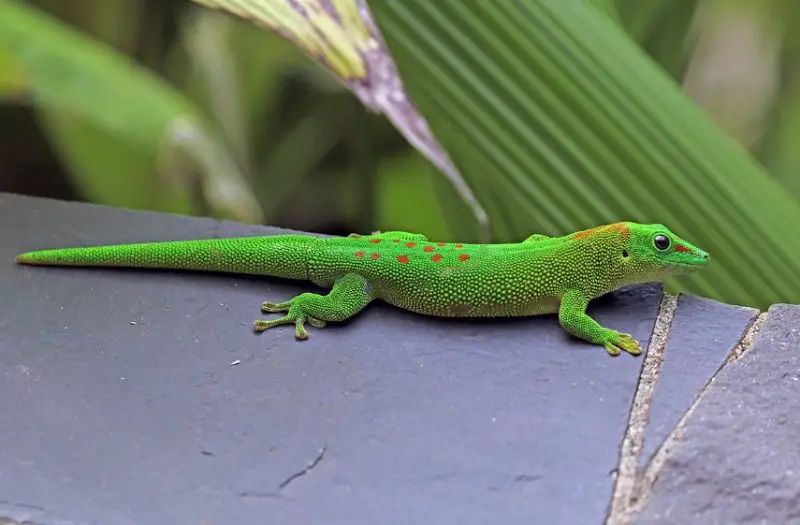
The Madagascar Giant Day Gecko (Phelsuma grandis) can reach lengths of up to 12 inches (30 cm). They exhibit vibrant green or blue-green coloration with a distinctive red stripe extending from their eye to nostril. Some have red bars or dots on their backs, while others may display blue dots or lack them entirely. Originally from northwest Madagascar, they have been introduced to Florida, where a few populations are recorded.
Mole Skink
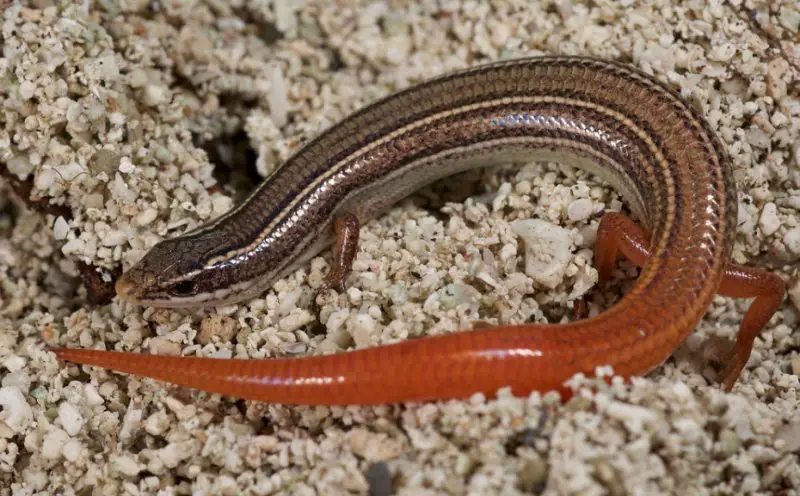
The Mole Skink (Plestiodon egregius) can grow up to 6 inches (15 cm), characterized by its slender body, short legs, and notably long tail. They vary in color from brown to gray, featuring two light stripes along their sides and orange or red tails that retain their color into adulthood. These skinks are adept burrowers, preferring dry, hot climates. Common in coastal dunes, they swiftly navigate sand to evade predators and can shed their tails as a defense mechanism.
Coal Skink
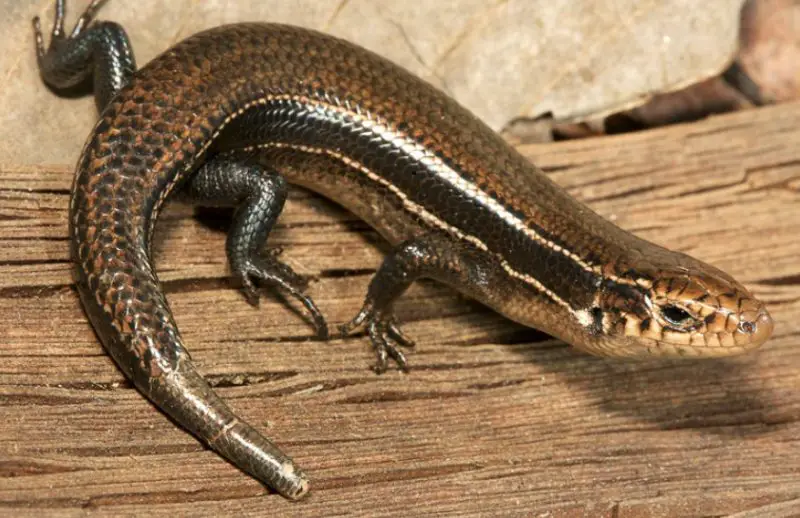
The Coal Skink (Plestiodon anthracinus) is a medium-sized lizard reaching up to 7 inches (18 cm) in length, known for its streamlined body and short legs. Typically brown or gray, they feature two yellow or white stripes along their sides but lack a stripe down their back, distinguishing them from other skinks. Found in forested areas and along streams, they prefer moist habitats and seek shelter under rocks and logs. When threatened, they may dive into water and hide under debris, employing tail autotomy as a defense mechanism.
Sand Skink
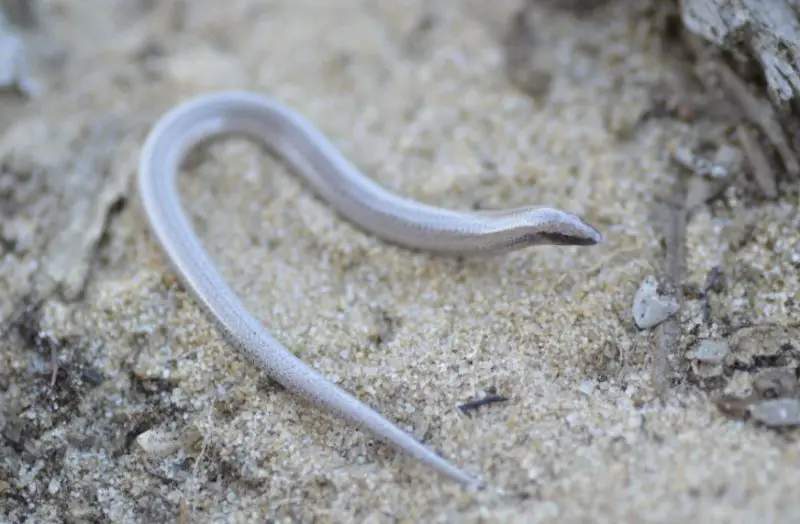
The Sand Skink (Plestiodon reynoldsi), also known as the Florida sand skink, is native to Central Florida, where it inhabits underground burrows. Growing up to 5 inches (13 cm) in length, they are tan or gray with small legs and tails that are half their total length. Found in vegetated areas with moist soil, they are elusive, with only 115 known sites recorded for their habitat.
Broadhead Skink
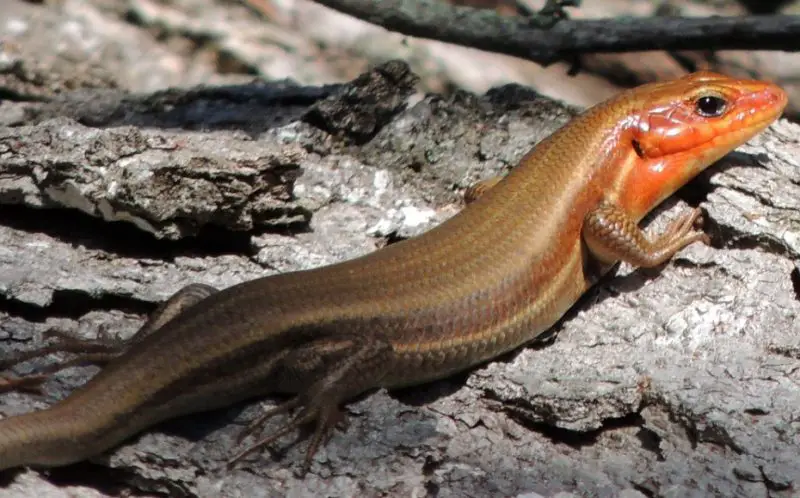
The Broadhead Skink (Plestiodon laticeps), also known simply as the broad-headed skink, is native and can reach lengths of up to 13 inches (33 cm), with males typically larger than females. During breeding season, males sport a glossy olive-brown to brown body with a bright red head, while females resemble the five-lined skink with light dorsal stripes. Found in leaf litter, moist soil, and decaying wood, they are commonly sighted in habitats like rotten logs and sawdust piles.
Ocellated skink
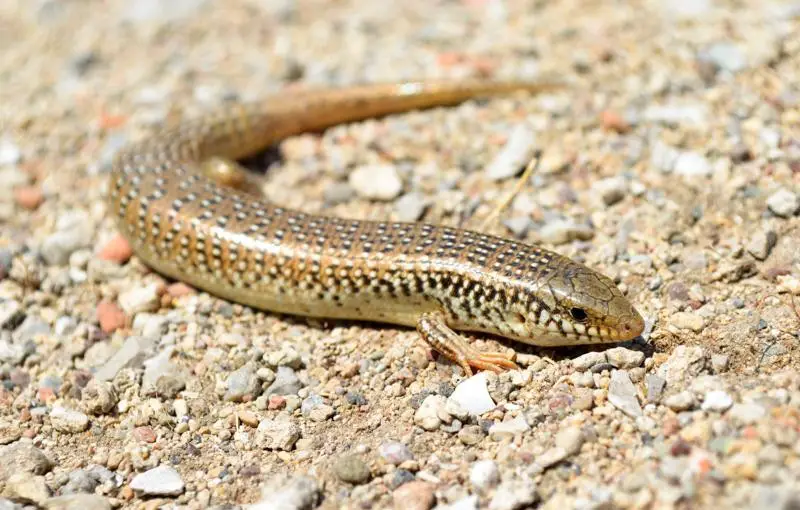
The Ocellated Skink (Chalcides ocellatus), also known as the eyed skink or gongilo, was introduced and grows up to 12 inches (30 cm) in length, including the tail. With a cylindrical body and small head, they can weigh up to 39 grams and favor drier habitats. Found in environments such as gravel deserts and farmland, they seek refuge behind vegetation to evade predators, relying on camouflage rather than speed.
Rough mabuya
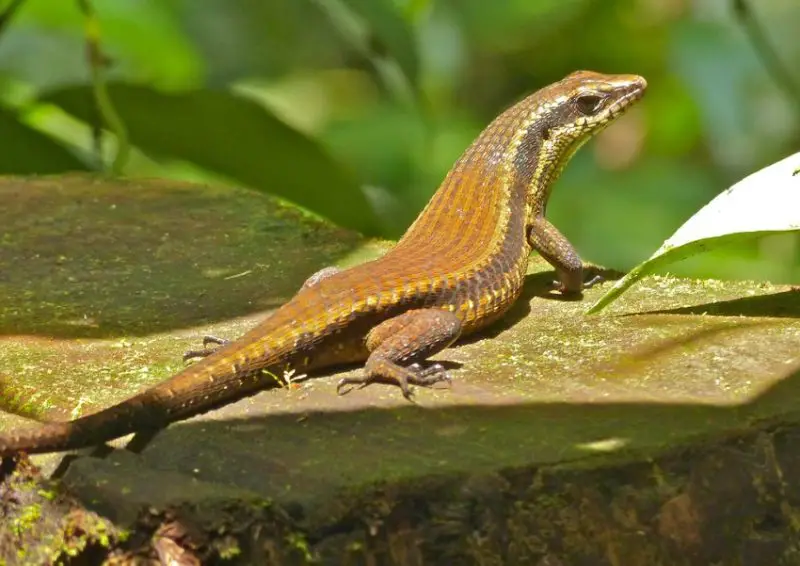
The Rough Mabuya (Eutropis rudis), also called the Brown Mabuya, originates from Southeast Asia, Indonesia, Malaysia, and the Philippines. Introduced to Florida, it remains rarely observed and secretive, with limited information available about its habits and distribution in its introduced range. This skink’s behavior and ecological impact in Florida are subjects of ongoing study and observation.
Rainbow mabuya
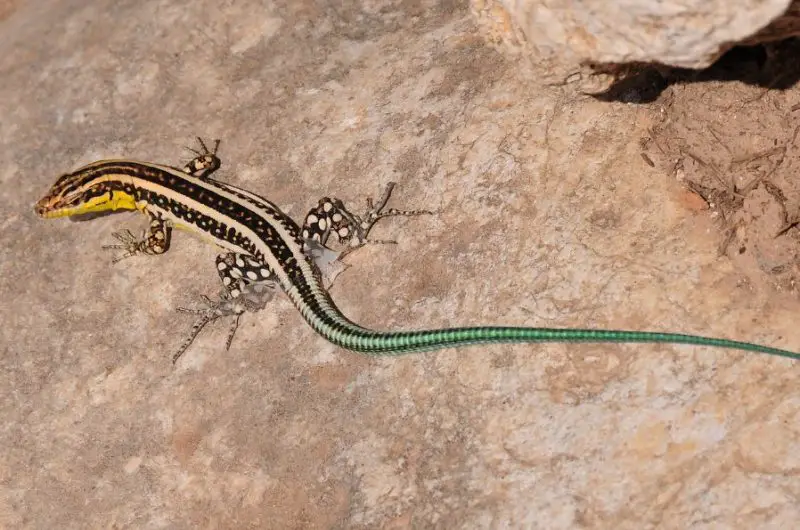
The Rainbow Mabuya (Trachylepis quinquetaeniata), also known as the African five-lined skink, is a medium-sized lizard reaching up to 20 cm in length. Introduced to Florida, it displays varying colors influenced by age and gender, often featuring glossy scales with metallic reflections. Typically dark brown or olive-brown, they sport pearl white spots and three yellow to orange stripes from head to bright blue tail, which may fade with age. Native to Africa, they have adapted to Florida’s environment since their introduction.
Five-lined Skink
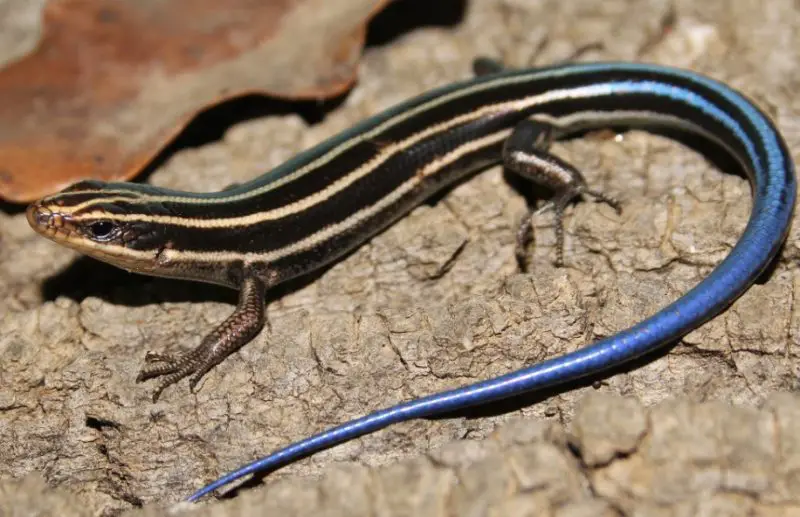
The Five-lined Skink (Plestiodon fasciatus), also known as the American five-lined skink, is a small to medium-sized lizard reaching up to 8.5 inches (21.5 cm) in length, including the tail. Juveniles are black to dark brown with five distinct yellow to white stripes and a vibrant electric blue tail, which fades as they mature. Adults typically become uniform brown, blending into their wooded, moist habitats. They are commonly found in building walls and other ground-level shelters.
Southeastern Five-lined Skink
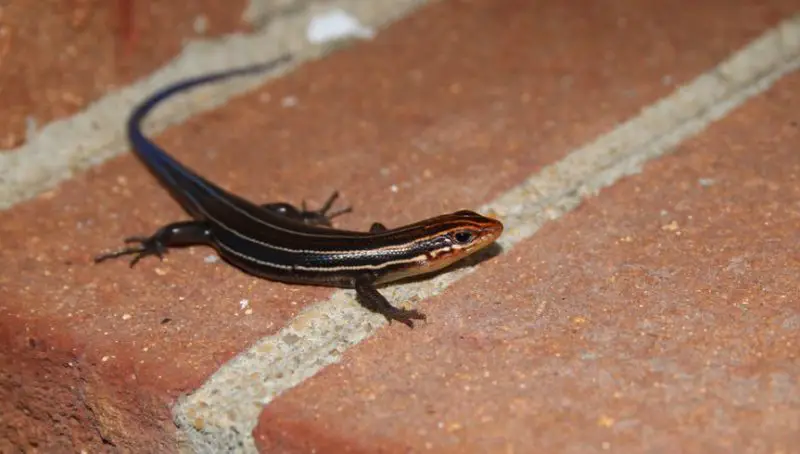
The Southeastern Five-lined Skink (Plestiodon inexpectatus) reaches lengths of up to 8.5 inches (21.5 cm). They have gray, black, or brown bodies adorned with five yellow to white stripes, including one down the center of the back and two on each side. Juveniles display bright blue tails, with males often developing an orange to red head coloration. These skinks inhabit dry wooded areas with ample tree stumps for hiding, where they are agile and elusive, using tail autotomy as a defense mechanism against predators.
Island Glass Lizard
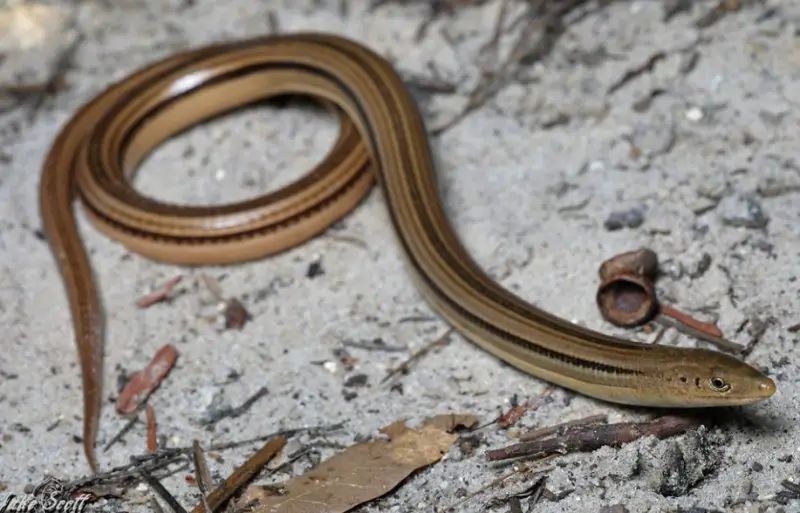
The Island Glass Lizard (Ophisaurus compressus) reaches lengths of up to 24 inches (61 cm) and is among the smaller glass lizards in Florida. Resembling snakes, they are slender, legless reptiles with yellow to brown coloring and a single dark stripe running down their sides. Found commonly in sandy habitats, they are primarily active in the early evening, hunting prey in open areas. Like other glass lizards, they use tail autotomy to evade predators by breaking off their tails.
Texas Horned Lizard
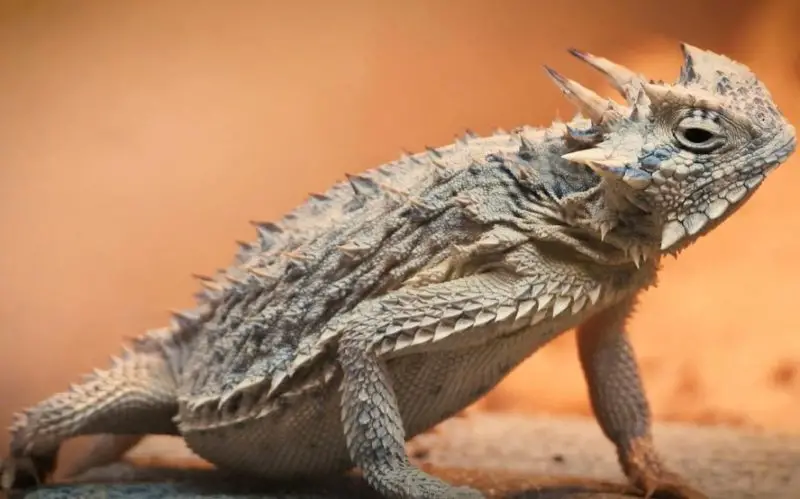
The Texas Horned Lizard (Phrynosoma cornutum), introduced to Florida, is one of fourteen spikey-bodied species known as horned lizards native to east Texas, Louisiana, and Arkansas. Once popular as pets, some believed to be escaped. Males grow to 10 cm and females just under 12 cm. Docile despite appearances, they bask in the sun and burrow at night to evade predators. Their diet primarily consists of harvester ants, often found near ant hills. When threatened, they puff up and can shoot blood from their eyes or mouth up to 5 feet (1.5 m), deterring predators with a foul taste.
Nile monitor
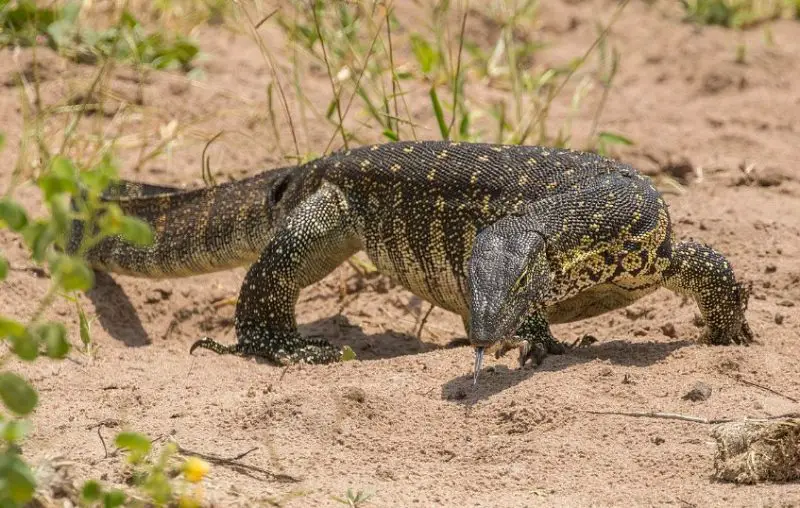
The Nile monitor lizard (Varanus niloticus), originally from Sub-Saharan Africa along the Nile River, was introduced to Florida. Growing up to eight feet (224 cm) long and weighing up to 15 kilograms (33 pounds), they are recognized for their muscular bodies, sharp claws, and forked tongues. In Florida, they are invasive, inhabiting forests, savannas, and waterways, feeding on a variety of prey, including snails, fish, frogs, snakes, birds, and insects.
Florida Worm Lizard
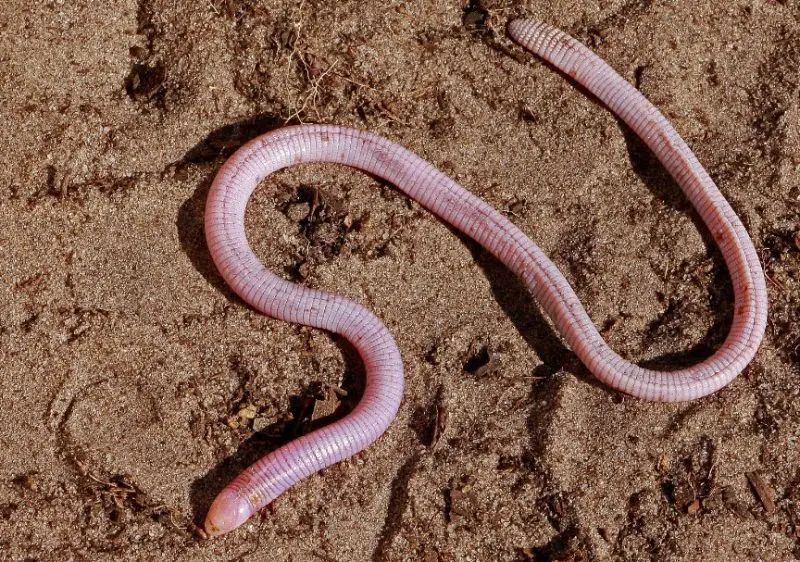
The Florida Worm Lizard (Rhineura floridana), also known as the North American worm lizard or graveyard snake, is native to Florida and occasionally found in Georgia. Belonging to the Rhineuridae family, they reach up to 30 cm (12 inches) in length. These legless lizards have a shovel-like snout, concealed eyes, and limbless appearance resembling a worm. They prefer burrowing in soil, sand, and leaf litter, emerging after rain to feed on earthworms, insects, and other invertebrates.
Eastern Glass Lizard
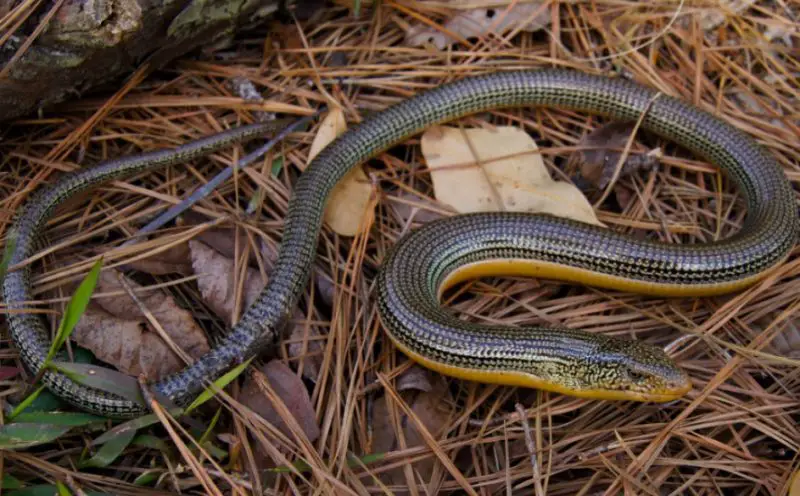
The Eastern Glass Lizard (Ophisaurus ventralis) is a legless, slender reptile native to Florida, reaching lengths up to 43 inches (108 cm). They are typically yellow, brown, or green in color and favor wetland habitats with sandy substrates, especially coastal dunes. Active during the day, they are often observed in open areas but quickly flee and hide when approached. Known for tail autotomy, their tail breaks off to distract predators while they escape.
Slender Glass Lizard
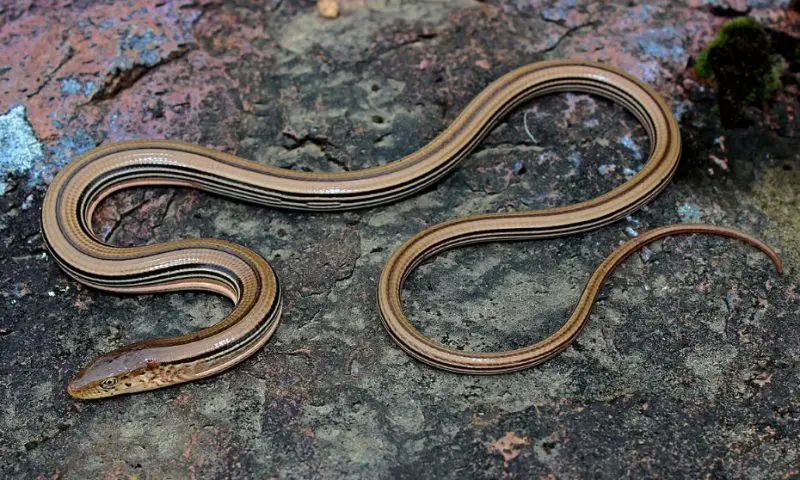
The Slender Glass Lizard (Ophisaurus attenuatus), a legless reptile resembling a snake, grows up to 42 inches (107 cm) long. They are brown to yellow with dark markings that may fade with age, often featuring a dorsal stripe. Found in dry, sandy habitats, they are active during the day and swiftly hide if approached. Like other glass lizards, they use tail autotomy to evade predators, breaking off a portion of their tail as a distraction.
Mimic Glass Lizard
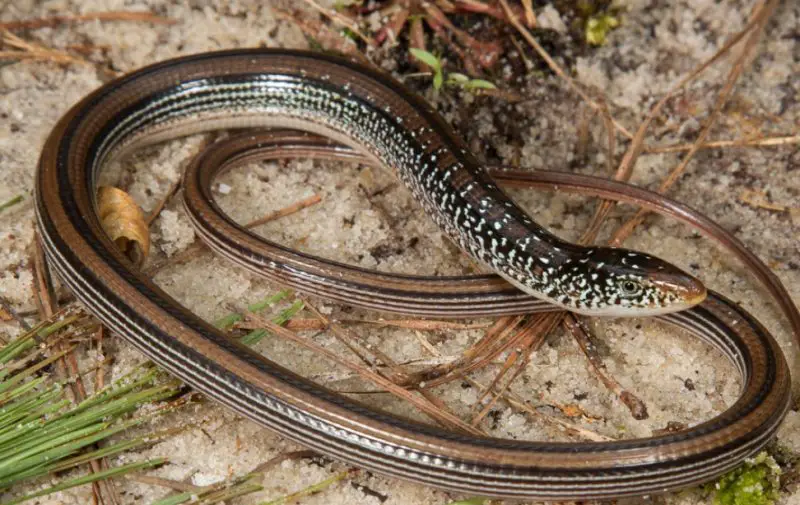
The Mimic Glass Lizard (Ophisaurus mimicus), also known as the rainbow glass lizard, reaches up to 26 inches (66 cm) in length, smaller than other glass lizards in Florida. It features yellow to brown coloring with dark stripes running down its sides. Found in dry habitats like flatwoods, they are diurnal and quickly seek refuge under debris if disturbed. Like other glass lizards, they employ tail autotomy as a defense mechanism against predators.


